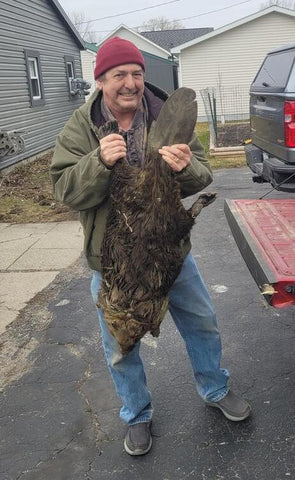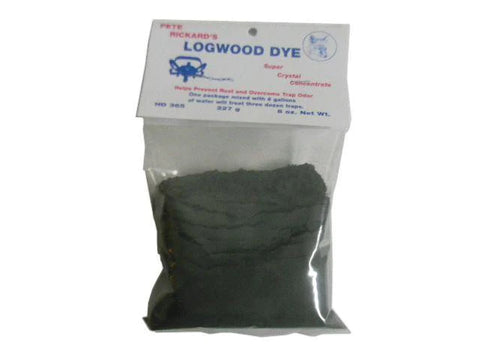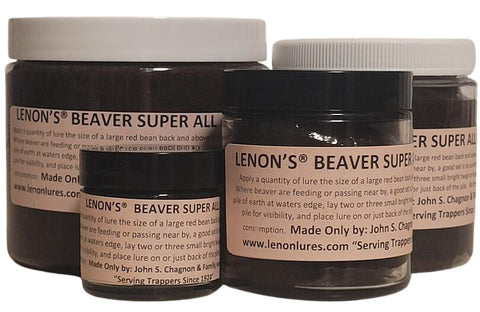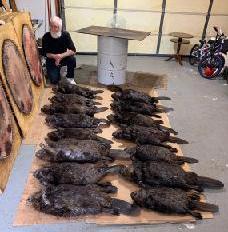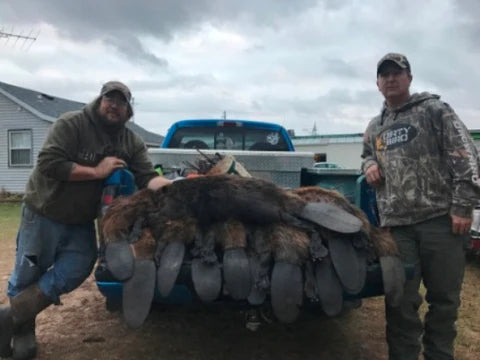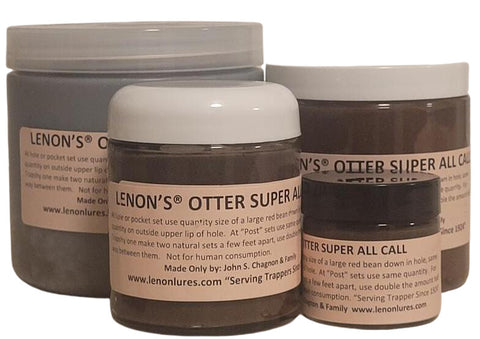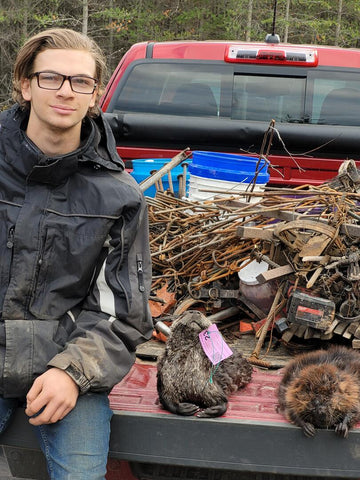Beaver and Otter Trapping Book by Herbert Lenon Free Online Version Everything How to Trap Beaver and Otter
BEAVER AND OTTER TRAPPING BOOK Online Version
by Herbert Lenon Copy Right 1946 Revised 2022
General Information
To become a successful beaver and otter trapper, as in the trapping of any animal, one must first learn the habits, food, and range of the animal as well as the sets.
I believe the biggest single factor in the unsuccessful trapping of any specie is the fact that too many trappers, young as well as the older trapper, think that the set itself is all important. Learning the food, habits and habitat of each specie is far more important than learning just the set.

If one will but give thought to the fact that a perfect set made for beaver, was made along a stream where there were no trees other than cedar, or made on a high dry ridge far from water, that a catch was far from probable, but that a less perfect set was made in the vicinity of a beaver dam, where poplar and other beaver food trees were plentiful, the chances of a catch in the less perfect set would have much greater possibilities; that thought alone should convince one that location is more important than the set.
Beaver are found along streams and other bodies of water such as lakes and deep ponds, but they are found there only when there is an available food supply.
The principal foods of the beaver are the several species of poplar, soft maple, black ash, tag alder, and various other trees. Beaver eats various grasses and plants, but only during the warm seasons, depending on the bark of trees for their winter food. Otter, unlike the beaver, eat much the same as mink; fish, frogs, mud turtles, and such probably being their principal food, with muskrat, beaver, and mink eaten occasionally.
Picture below an excited new trapper with a nice beaver 2024

Beavers usually have dams and houses in which they stay the year around if food is available, during the spring just after the ice is out, the male beaver and the young beaver from the second spring before, often move for many miles, sometimes moving up or down stream, and at other times moving across country for miles. I have found tracks of beaver way out in the dry plains, miles from a stream or water, where they have moved cross country to another stream or lake.
Trapping Books Written By Herbert Lenon FREE online versions.
- Secrets of Successful Trapping Fox, Coyote, Bobcat Trapping by Herb Lenon
- Beaver and Otter Trapping Book Online by Herbert Lenon
- Mink and Muskrat Trapping Book Online by Herbert Lenon
- Raccoon, Opossum, Skunk and Weasel Trapping Book Online by Herb Lenon
The old female beaver seldom moves in the spring as their young are usually born in April or May; however, if one escapes from the trap, or if the trapper frightens them, they will sometimes move for miles.
Many people believe that bank beaver is a different species of beaver than those that live in a house; that is not true, a bank beaver of one year may have been a house beaver the year before and moved only because the food gave out where it previously lived.
Most beavers that live on small streams build dams and houses; the dams are built to give the necessary water depth and to facilitate the floating of logs from the bank to the house or feed bed.
Bank beavers are quite often an old male beaver that some younger beaver had driven out, however, the most common reason that some beaver live in holes in the bank is because they live along some large stream where the size or swiftness of the stream prevents building of a dam.
Otter is more like mink in their habits; they are great travelers, usually having a regular circuit of many miles in circumference. Many trappers believe that otter just roam here and there with no regular circuit; that take many days to cover, it nevertheless has a regular circuit.
When making this circuit otter usually have some particular place where they spend the night each time they pass through; usually this is the den in which they, or other otter have been born, although it is not unusual for them to spend the night in a deserted beaver house or home.
When one finds a beaver house or home, or any den in which otter have spent the night, one has located a good set, for invariably they again spend the night there on their next trip.
During cold weather when streams are frozen over, one often finds a body of dead water, such as an old beaver dam, in which a bountiful supply of otter food is available and in which otter sometimes stay for several days each time they come by. When such a place is found one will often find a small open place in the ice where otter come out to eat and to leave their droppings: Such a place is a very likely set; or one may find a den where a litter has been raised, if so, a trap properly set in the den will usually take every otter that passes through.
Beaver Trapping
John Chagnon March 2024 Blanket Spring Beaver using our Lenon's Beaver Super All Call Lure
When trapping beaver in the spring, one should remember that beaver often move during the period following the opening of streams and dams, usually within 2 weeks from the time dams or streams are free of ice.
Considering this factor, one should have a good set made a quarter or half mile both above the dam and below the dam as well as several sets at the dam.
When one has plenty of traps and time to tend them, it is a very good policy to have an occasional set made along the larger streams to take the transient beaver, even if no beaver signs are noted there when the trap is set.
The most popular size trap used for beaver is the number four, personally I prefer the number 14 Oneida jump trap as it has a widespread and heavy teeth that often hold a beaver by the shoulder that has previously lost a front foot in a trap. If the 14 Oneida is to be used for beaver exclusively, it is a very good idea to cut the pan down to about half the size it comes with, for with the large trap pan, and even with a small pan, it is quite often the large sprawling hind foot of a beaver is partly on the trap pan, and partly on the jaws, thus the jaw kicks the foot upward as the trap closes; and only a toe is gripped: Most beaver will escape, even if in deep water, when caught only by one toe.
New traps should be cleaned and tanned before setting. New traps usually have a coating of grease or oil when they arrive; if traps are set in quite water with such a coating of oil, the oil rises to the top of the water and its odor will spread to the grass and bait in the vicinity of the trap. This oil should be removed by boiling the traps in a solution of water and lye; one can of lye to five gallons of water; boil 2 hours, let soak overnight, boil again an hour or so, then pour the water off quickly.
After some cleaning, wash in clean water to remove the lye and loose oil or rust.
After cleaning new traps, they must be rusted slightly before tanning; new shiny traps will not color.
To rust the traps, lay them in the grass where they will be wet by dew or rain, turn occasionally so they will rust evenly. If during a dry season, one may wet them occasionally to rust them more quickly.
After traps have become lightly rusted, boil them in a solution of water and either extracts of logwood or dyewood in a strength of one-fourth pound of the extracts to 4 or 5 gallons of water. Boil for 2 hours; using a hook, hook the traps from the water while boiling; hang up where they will dry quickly.
When dried quickly the traps should be a dark blue black; if they are not dark enough, boil again by adding more dye.
The purpose of the dyeing is to make the traps less conspicuous, and to prolong their life by preventing rust.
Purchase Lenon Lures Wax and Logwood Trap Dye
Purchase Lenon Lures Wax and Logwood Trap Dye
Traps should be boiled in dye every time they show rust. Traps kept properly dyed are much more easily concealed; are surer to work properly, as they are not slowed up by rust and corrosion and will last at least three times as long as traps that are allowed to become deeply pitted with rust. A rust pit only one thirty second of an inch deep, in a trap spring one sixteenth of an inch thick, is halfway through. Traps should always be checked very closely for improperly fastened chains, improperly fitted jaws, and for the pan action. Adjust the pan action by bending the frame back or ahead to such a position that when the trigger is in its foremost position, the trap will spring when the trap pan is one-fourth inch from the bottom of the trap frame.
Beaver Lure
As good a beaver lure as I have ever used is made thus. Mix well together two ounces of finely ground beaver castor, one ounce of oil from oil sack of beaver, one ounce of glycerine, two drops each of oil anise and cassia.
Use ten drops at each set.
or Purchase our Lenon's Beaver Super All Call Lure available in 4 sizes
Lenon's Beaver Super All Call Lure
The Sets
Nice picture Spring Beaver catch sent in from Bill Northern Michigan
Sets can be classified as bait sets, lure sets, trail sets, and lure or bait trail sets.
It is not my intention to write about twenty-five different sets as is the policy of some writers, to fill up a lot of pages with worthless or impractical sets that only confuse the trapper. It is my intention to explain only the few best sets as simply as I can.
The Regulation Bait Set
This old reliable set is used by all trappers; I believe that at least 50% of all beaver trapped are trapped in this set. When making any set for beaver, one must first choose a location where one has good reason to believe the beaver will pass close to the trap and see or smell the bait or lure. Next, one should choose a location where the trap can be set in the proper depth of water, 3 to 8 inches for front foot, 10 to 18 inches for hind foot catch.
Lastly, one should choose a place where the beaver can reach water on ones sliding pole or wire, that is deep enough to drown the beaver quickly: About 2 ½ feet is the minimum depth required for drowning.
After a suitable set location is chosen, place the trap in the chosen spot; fasten it to the drowning pole or wire. Now about 3 inches to the right and about 4 inches out in stream from the trap, place solidly a guide stick of dead material, to the left of the trap about 8 inches and out in the stream from the trap about 4 inches place another dead guide stick, thus the guide sticks are about 16 inches apart, with trap setting somewhat to the right of the center of it body.
About six inches in toward shore from the first two guide sticks, place two more, place them about one foot apart to narrow up the approach to the bait; these guides must look very natural and should be well weather-beaten material.
Now back of the trap at the shores edge, about eight inches from the trap, place your bait.
The bait should be from the favorite beaver food of that area, the light green branches of quaking aspen are best.
Quaking aspen are the light green poplar with small leaves. Use about 8 branches about 18 inches long and press one end firmly in the ground.
On the top of the center piece of bait, place about 10 drops of beaver lure.
Now the instructions are given for catching the beaver by the right front foot; if you wish to trap them by the hind foot; place the guides and bait the same but place the trap out from the bait 18 inches and to the right or left about six inches, as their hind feet are about one foot apart. A water depth of 8 to 12 inches in open sets is best. See pegging traps for a high catch or for choosing the large size beaver.
Regulation Under Ice Bait Set
Where one is trapping under the ice, and the water level is six or more inches below the ice, make the set the same as just described for open water.
However, if the set is made under the ice, where the water is up to the ice, as is usually the case, then the depth of the water must be greater.
The depth of the water under the ice should be about eighteen inches deep; this depth of water is necessary to allow the beaver to easily approach the bait, as well as necessary space to allow the bait being seen easily by the beaver.
After choosing a location where the water depth is as described, place your guides, bait, and trap the same as explained in the open water set.
The sticks used for bait in this set should be long enough so that when one end is pressed firmly in the bottom, the top ends will protrude above the ice and freeze solid in it.
Where the ice lays on the water, it is necessary to use a drowning pole or wire unless the weather is warm and there is danger of the hole not freezing and the beaver reaching the hole for air.
Bait Set for Trap Shy Beaver
Occasionally one finds an old-time beaver that has become wise to the regulation bait set; also, one occasionally finds one of these old timers that are also wise to the use of lure or even plain beaver castor.
When one realizes that one has such a wise old fellow to trap, one must either trap it in a trail set, in an opening made in the dam, or with the following bait set.
For this set one must choose the trap location carefully and conceal the trap with mud or water-soaked leaves.
For trap location, try and find a small inlet or body of water about a foot or so wide and extending back from the large body of water a foot or more.
When such a place is used, there is no need of guide stakes for with such beaver guide stakes must not be used.
The trap is set and covered in this chosen location, for bait one uses just one small tree; this tree must be cut so and planted so that it looks exactly as if it has grown there. It should be planted back of and to the right or left of the trap the same distance as explained in the regulation bait set. No lure is to be used at this set.
Sam Wood from Wisconsin poses with a nice days catch of beaver using Lenon's Beaver Super All Call Lure. Thank for sharing the pic Sam.
Deep Water Sets
There are many, many different types of deep-water sets, however they are all set with the same thought in mind: The placing of the trap on some form of support other than the bottom of the stream or pond: They can be used in open water or under the ice.
The Ladder Set
The ladder set is just one type of trap support where two small poles are nailed together with slats to resemble a ladder, the poles are placed about six inches apart; where the trap is to be set, there is usually about 4 slats nailed two inches apart, thus making a support about 8 inches square.
Trap is then set on this support and fastened so it will not be brushed off, fresh green bait is fastened to the ladder above the trap; ladder is then pushed into the bottom of the stream or pond at a slope of 45 degrees.
The principle being that when the beaver tries to get the bait, it will become caught in the trap just under the bait.
In open water have the trap under 8 inches of water; under ice have trap below the ice about 15 inches.
Trap should be about 6 inches from the bait.
The Shelf Set
Another trap support set is made thus.
Using a dead pole about 5 to 8 inches in diameter, nail two pieces of a stick about a foot long to the pole, one on each side and extending straight out from the pole; set the trap on these two branches and fasten so it will not be brushed off; or nail a piece of board about 8 inches wide and a foot to the pole with two small branches from the outer end of the board down to the pole several inches below, just as you would build such a shelf in your house or out buildings.
With either shelf trap support, fasten the trap so the beaver will not brush the trap off, and fasten the bait to the pole just above the trap.
The Post Set, Under Ice
Some trappers use a post with a six-inch top, the trap is set and fastened to the top of the post; the post is then pressed in the bottom so that the trap is under about one foot of water, fresh green twigs are used for bait; they are placed above, or a little to one side of the trap and allowed to freeze in the ice. As the beaver attempts to procure the bait, it becomes caught in the trap set on top of the post just below the bait.
The Diving Bait Set, Under Ice
Where it is necessary to set a trap on the bottom and in from 2 to 5 feet of water, a single bait pole is usually used. Cut a fresh green bait pole about 2 feet longer than the water depth, push this bait pole into the bottom so it is solid, and so the top will freeze in the ice.
Set one or two traps on the bottom about 6 inches from the pole. As the beaver sees the bait, it will usually cut it off just below the ice, then dive to the bottom intending to cut it off there; it becomes caught when attempting to cut the bait at the bottom.
The Castorium Post Set
The castorium post set is a set made to lead the beaver to suppose it is a castorium post where other beaver have rolled up the mud and deposited castorium therein.
Find a low sloping bank, a muddy bank preferred, choose the location for your set the same as in a bait set: Place the trap and just back of the trap and at water’s edge, lay a few small twigs from which the beaver has eaten the bark.
Now roll a pile of mud up over these sticks, have a pile of mud 4 to 6 inches high 6 to 10 inches long, do not use sloppy, soft mud, saturate the mud with beaver castor or preferably castoreum; use plenty of it.
If a strong lure like my beaver lure No. 1 is used, use about one teaspoon.
The beaver is caught as it approaches to investigate or to deposit its castoreum therein.
The Trail Set
The trail set is just what its name implies, it is used usually for bait shy beaver and is made in a trail used by beaver, this trail may be where they go over the dam, upon the house, or it may be a trail they use when going to available food. Where water is over 6 inches deep, use pegging sticks.
The Lure Trail Set
The lure and trail set are usually used where beaver is trap shy or where other suitable sets are impossible to make.
Choose a good location for trap in a beaver ditch or small narrow body of water suitable for making a set.
Place the set the same as in a trail set.
About 20 feet back of the trap place the lure, you can use a good quantity of beaver castor or lure, or as I often do, I use about a teaspoon of lure made from half oil anise and half oil cassia. The lure is usually placed on a tree or such, near the trail and about 2 or 3 feet above the water level.
A beaver seldom comes right up to such a lure but will often swim over near it to investigate and is caught in the trail set.
Otter Trapping
I have never made a profession of otter trapping; in fact, have done very little of it; however, I spent many days on an otter trapline with the best otter trapper I have ever known. This trapper, now dead, was an old-time professional beaver and otter trapper that came to the Tahquamenon area from Canada: He was the best otter trapper I have ever known, many times bringing in two and three otter a day while the usual trapper got few more than that in a year.
Any trap used for beaver is satisfactory for otter; this old trapper always used traps with teeth; his favorite was the No. 3 ½ Newhouse: It is not made any more.
Otter Lure
Here was the old timer’s favorite lure.
One otter musk sack, found at the vent, one mink musk sack, one ounce sun rendered oil from otter fat, mix well and set in sun tightly corked for several days: Use 5 to 10 drops.
Lenon's Otter Super All Call Lure
Lenon's Otter Super All Call Lure
The Narrow Passage Set
The narrow passage set was the favorite set of this old expert.
Narrow Passage No. 1:
Find an old unused beaver dam which still holds water. In the center of the dam, cut a notch 10 inches wide and deep enough so that 8 inches of water rushes through the notch. Set the trap in this notch with the solid jaw up stream and free jaw down.
Use a small crotched stake to hold the trap solid, raise the free jaw, which is down stream, up one-third way, fasten it up with a small crotched twig so that when the otter slides through this passage, one or both of its front feet will slide under the upraised jaw and a high catch is assured.
Narrow Passage No. 2:
Find where a large moss covered partly rotted log lays across the stream with part under and part above the water, tip back the moss and cut a notch the same as in the beaver dam set, tip the moss back to cover the fresh cut, if fresh cut shows, smear with mud.
When setting trap in this set, set with spring up stream and with jaws to each side not with one jaw up and one downstream.
Narrow Passage No. 3:
Where otter are travelling a small narrow stream, either under ice or in open water, drive stakes about an inch or two in diameter, two inches apart, across the stream, it is best if these stakes are driven in early fall so the fence has time to age, in the center of a stream less than 5 feet wide, leave a passage 10 inches wide, in streams 5 to 8 feet wide, leave 2 passages about two feet apart, set the trap in these passages with jaws to side, not one up the other downstream.
Try to choose places for this set where water is about 8 inches deep in open stream and not over a foot deep under the ice, if water is deeper, block off the passage at the bottom and set the trap on a support.
The Den Set
As previously mentioned, one often finds a den in which otter spend the day while making their circuit; this den may be an old beaver hole, a deserted beaver house or possibly a den in which young otter have been raised.
Dens in which otter are raised are usually used until winter and then used for a day or more each trip.
When such a den is found, set the trap out from the mouth of the den a foot, so that the otter will not spring the trap with its chest as it enters the den. If the den is used considerably, it is a good policy to set two traps, so a catch is assured before otter is wise to the den being trapped.
Tobyn and John Visited Asa Lenon Winter of 2024 on Otter Trapping Trapping Trip in UP.
The Dirt Hole Set
When a portion of a stream or lake is found in which the otter feeds, a satisfactory set can be made thus.
Dig a hole 10 inches in diameter, 2 feet deep, straight back into the bank, dig it so that there is 5 inches of water in the hole, throwing all earth out into the stream.
Set the trap 10 inches in front of the hole, underwater, place lure back in the hole one foot, being sure the lure is above water.
Drowning and Skinning Methods
Otter and beaver must be drowned soon after they are caught or there is a great possibility they will escape.
The sliding pole and slide wire is most widely used.
The sliding pole is made from a tag alder or similar tree, it is cut long enough to reach from the trap to deep water. A large branch is left to prevent the loop sliding off the end if the pole is pulled from the bottom, a straight portion of the tree is pressed firmly in bottom of stream or pond, in deep water, branches are cut off with 2 inches protruding so loop slides down the pole as otter or beaver dives for deep water, but when it attempts to return to shore, the branches prevent the loop sliding back up the pole.
If not enough branches on the pole, headless finishing nails can be driven in the pole at a 45-degree angle, heads of nails sloping toward deep water end of the pole.
The loop should be of 2 strands of telephone wire, 5 inches in diameter and should be fastened as near the trap as practical. The sliding wire is usually a wire about the size of a telephone wire or smaller, this wire is either staked in deep water or a bag of sand, or weights, is fastened to the end, and then thrown in deep water; the shore end is fastened at edge of water with a stake.
A one-inch angle iron, with a hole in each angle, is fastened to the trap as near the trap as possible, the slide wire is threaded through the other hole, as beaver or otter dives for deep water this angle iron slides down the wire, but as the beaver attempts to return to the shore, the angle kinks and will not slide back.
Skinning
The otter is skinned the same as a fox, mink or weasel, the shape of the hide is same as a mink or weasel after stretching, as otter are difficult to skin, due to their tough fat, it is best to remove all the fat with a round point skinning or fleshing knife as the pelt is removed.
The beaver is skinned open and stretched round or nearly round, I use chicken fence staples when stretching as they give two holdings points each.
Before skinning a beaver cut off the four legs and tail just at the hairs edge, then make just one single cut from the center of the tail on the belly straight to the center of the lower lip; no other cut is made; the skin is then cut off using a fleshing knife, leave the fat on the carcass, thus fleshing as skinned.
Pegging Traps
In pegging traps, one used three small sticks about the size of a pencil in diameter and of the necessary length: They are sharpened at each end, their purpose is to establish an obstruction to contact the beaver’s chest as it approaches the trap or bait, and thus cause the beaver to put its hind feet on the bottom to push them aside.
Where a trap is set at bait, place these pegging sticks firmly in the bottom at a 45-degree angle with their ends 2 to 3 inches under water and pointing in the direction of the beaver’s approach. The ends of these peg should be out 8 inches from the bait so as the beaver’s nose nears the bait, its chest contacts the pegs, it then places its hind feet down on the bottom to push them aside. Pegs used in a trail set should be so placed that when the chest touches the pegs, the hind feet will be over the trap.
To select all large, extra-large, or blanket beaver, set the trap as explained in previous bait sets for hind foot catch.
As it is probably 15 inches from a beaver’s chest to its rear feet, on a large beaver, and as the pegs are out 8 inches from the bait, the trap is then set out 2 feet from the bait, in a foot or more of water and 6 inches to right or left of center.
When the chest of a small or medium beaver touches the pegs, it lowers its hind feet to push, but as their body is shorter and hind feet nearer together, the hind foot does not contact the trap, but when the larger, longer, and wider beaver contacts the pegs, it lowers its hind feet to push, the trap being back farther and more to the side, they are caught.
When pegs are used, one usually has a high catch by hind foot and chances of the beaver escaping is very small.
Before becoming an expert trapper of any animal one must first know the habits and habitats of that animal, then one must know its food and where such food is most easily procured at the season one intends to trap, but of greater importance is the fact that one must have the ability to reason and think logically.
The successful trapper uses his head as much, or much more than he uses his feet.
Yes, in order to be an expert trapper of any specie of animal, one must first study the animal one wishes to trap.
The observing trapper is always on the alert for sign denoting the presence of furbearers, and by being on the alert he will note many places where some special type of set not listed in this book, can be made.
These sets may be a good trail set where one has noticed where an otter in traveling from one stream to another has used a small narrow body of water, or where it has travelled an old deer trail or road grade.
It may be a set where beaver or otter cut across a narrow body of land for a few yards from one part of the stream to another where the stream makes an abrupt turn, and later comes back very near its course.
I know of one particular place where a stream turns abruptly to the east, it flows east about one-fourth mile, then to the south and back to the northwest; after flowing nearly three-quarters of a mile it comes back to within 20 feet of where it turned eastward.
Across this narrow place separating the stream is a wide well-worn trail that has been worn by beaver, otter, muskrats, and mink probably throughout many scores of years of time. Where this trail leaves and enters the water would make a very productive set, and in such places a trap should be set in the water at each end, and another trap or more set dry in the trail between.
I have written this book the very best I know how; if it is studied carefully, it should be of great value to you, not so much in teaching you how to make a set, but by teaching you to be observant and by getting you started on the right and simple road to success.
Trapping Books Written By Herbert Lenon FREE online versions.
- Secrets of Successful Trapping Fox, Coyote, Bobcat Trapping by Herb Lenon
- Beaver and Otter Trapping Book Online by Herbert Lenon
- Mink and Muskrat Trapping Book Online by Herbert Lenon
- Raccoon, Opossum, Skunk and Weasel Trapping Book Online by Herb Lenon
Lenon Lures Online Product Catalog
Give the Best Beaver and Otter Lures a try ... since 1924
Lenon's Beaver Super All Call Lure
Lenon's Beaver Super All Call Lure
Lenon's Otter Super All Call Lure
Lenon's Otter Super All Call Lure
Herbert Lenon and John Chagnon Otter / Water Trapping Videos Dvd's
Herbert Lenon and John Chagnon Otter Beaver / Water Trapping Videos Dvd's
Ebay carries all of Lenon Lures® products and is a great place to find deals on all kinds of used and new traps and beaver & otter trapping equipment at great prices.
Follow the links below to some more great trapping information ...
- Secrets of Successful Trapping Fox, Coyote, Bobcat Trapping by Herb Lenon
- Beaver and Otter Trapping Book Online by Herbert Lenon
- Mink and Muskrat Trapping Book Online by Herbert Lenon
- Raccoon, Opossum, Skunk and Weasel Trapping Book Online by Herb Lenon
- Herb Lenon Trapper's Hall of Fame Article
- Herb Lenon 1947 Full Page Ad in Fur Fish Game Magazine
- How To Trap Fox & Coyote - Herb Lenon and Asa Lenon
- Mink Trapping by Herb Lenon Article 1946
- Trapper's Bible of Trapline Secrets, Sets and Knowledge by Herb Lenon
- Monthly Tips on How To Trap by John Chagnon & historical writings Herb and Asa Lenon of Lenon Lures

